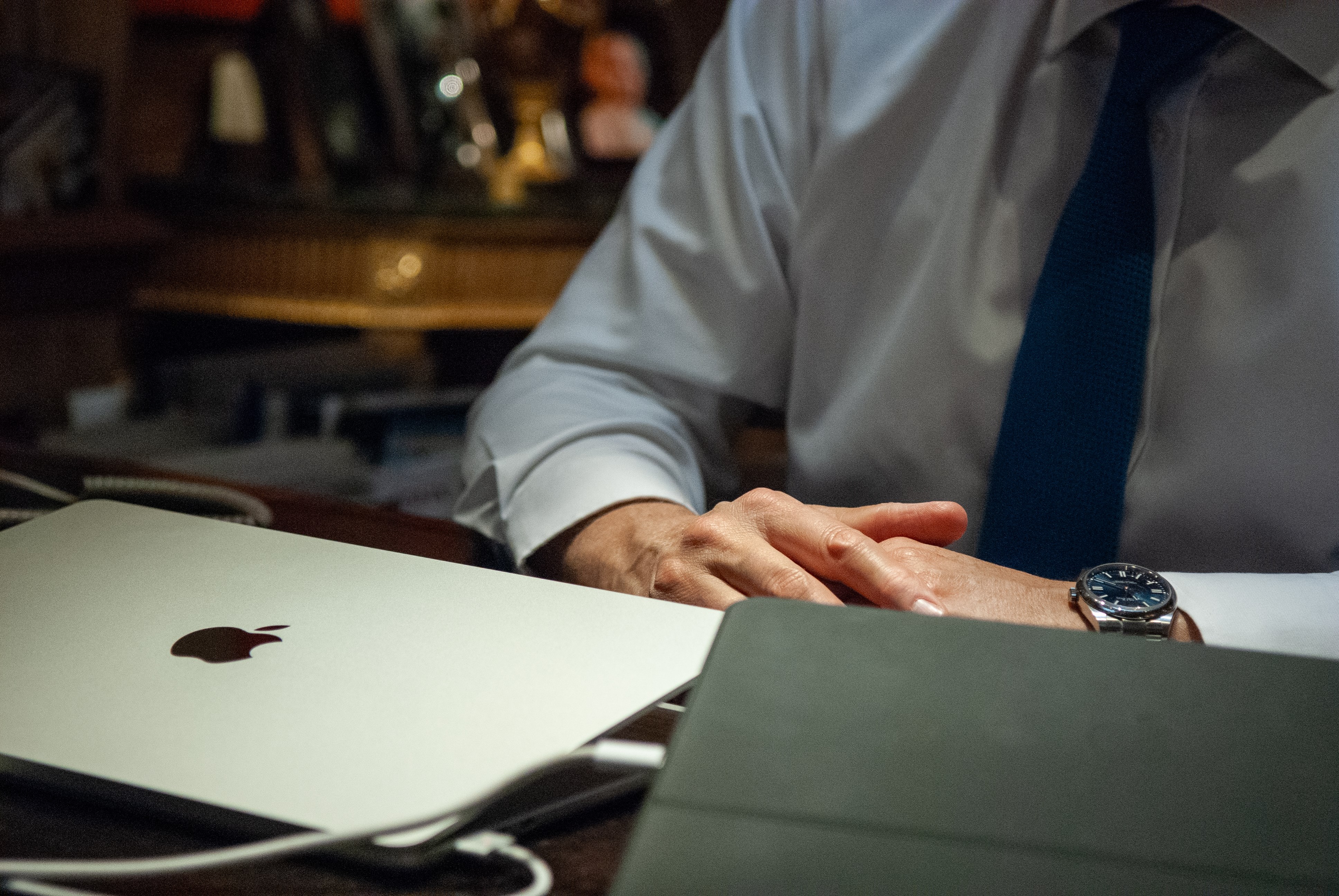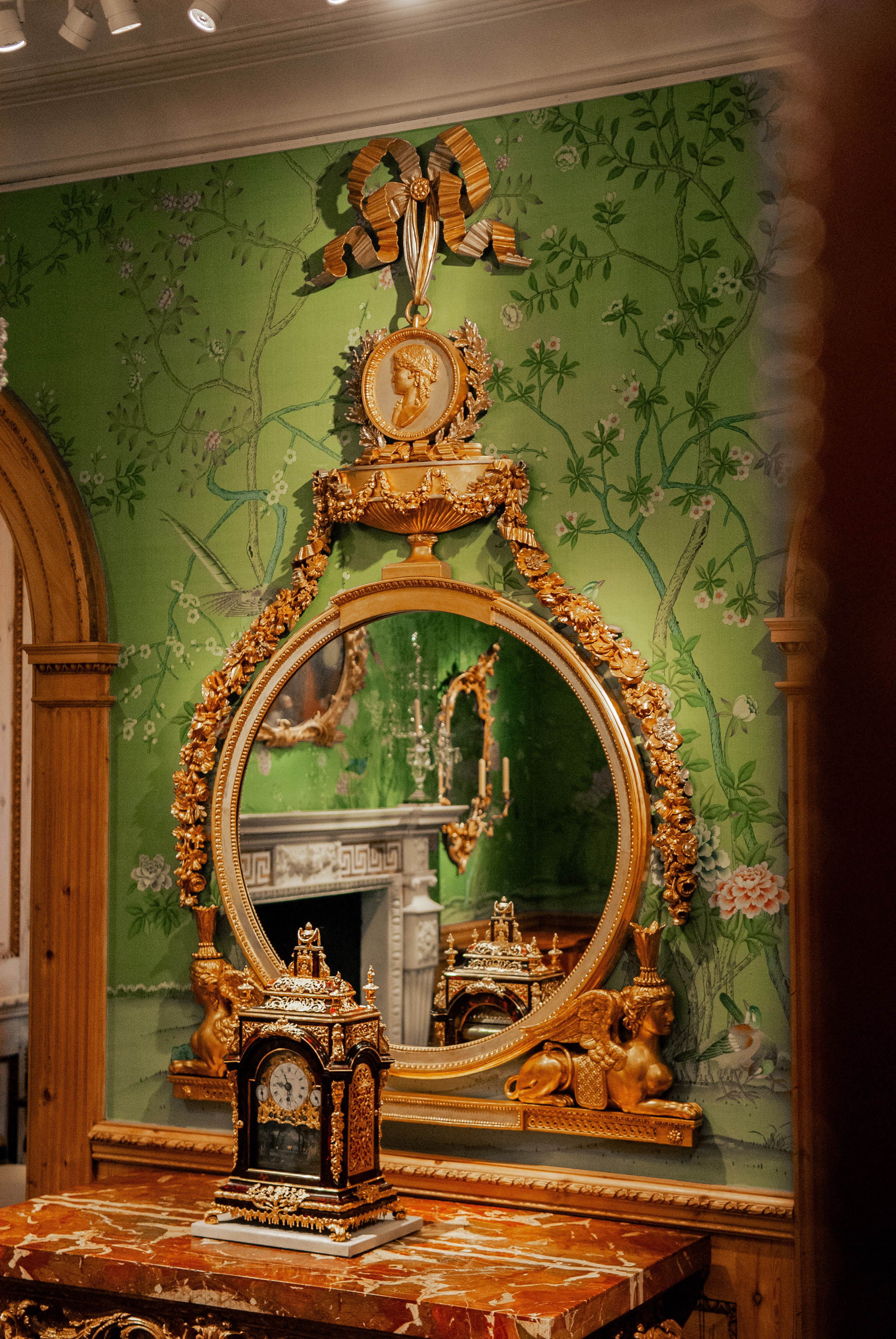Four Decades in the Antique Furniture World
25 April 2025
Share
By Catherine Milner, Treasure House Fair Magazine Editor
As Simon Phillips sits in his Bruton Street office in Mayfair, where he has worked for over 40 years, he reflects on the changes in the furniture business since he first entered it—just two weeks after his 18th birthday. “In those days, furniture dealers were everywhere,” he says, effortlessly listing half a dozen in Mayfair alone—Mallett, Partridge—all of which have since disappeared, along with several others down the Fulham Road and King’s Road.
Now, like a magnificent lone tree, his storefront window on Bruton Street gleams with golden mirrors, polished mahogany cabinets, and damask-upholstered chairs—a cabinet of exquisite treasures inviting one into another world. Thread through the gallery past a carved wood console table once owned by John Paul Getty, a Chippendale writing desk, and a pedestal from Newby Hall, and you’ll find Simon’s office tucked discreetly at the back. Sitting behind a large desk adorned with family photos and a picture of himself being hugged by a chimpanzee, it is clear he leads a fulfilling life. “I still love living with these things,” he says, gesturing toward an 18th-century mirror behind him—the one piece he insists he will never sell. “Matthew Boulton is still popular,” he adds, pointing to a pair of candle vases—ingeniously designed vases whose tops can be reversed so that they can hold candles.

Simon in his office.
The first items Phillips remembers selling were two pillar dining tables. When he started, his father, Ronald Phillips, employed just one restorer and primarily traded within the trade. “Now, I employ 15 staff—two restorers, two upholsterers, gilders, van drivers, researchers etc,” says Simon. Ronald remains actively engaged with the company, albeit from his bed in his retirement home. “He’s still very interested,” Simon notes, “mainly in whether pieces he sold have come back on the market. We have one mirror in the loo that he sold in 1965!” But Simon is more than a custodian of fine objects; he is also a steward of the craft skills that originally created them. In the basement of his gallery is a large workshop, where pieces are not only restored to their former glory but meticulously researched, ensuring a depth of knowledge rarely found outside a museum. While the internet has expanded the antique furniture market, it has also disrupted it.
“In the old days, an interesting piece would sell in a Yorkshire saleroom, and it would change hands five times with every dealer making a profit before reaching London and then a private client,” Simon explains. “Now, that’s all gone.” Today, he sells only the finest and rarest examples, catering to a discerning clientele who are more knowledgeable than ever and advised. Many of his pieces are distinguished as much by their provenance as by their craftsmanship.
He is currently offering a Carlton House writing desk once owned by Mark Birley, founder of Mark’s Club and Annabel’s, and another previously belonging to actor Sir John Mills. Other works are identified by the stately home from whence they originated. A George III giltwood mirror from the White Drawing Room at Harewood House by Thomas Chippendale, is a prime example. Adorned with garlands of gilded wooden flowers cascading down either side of a round looking glass, it rests on two golden sphinx candleholders and is crowned by a cameo of a woman framed by fluttering ribbons.

The Harewood House Mirror, English, circa 1780
The finesse of the woodcarving in such pieces would be almost impossible to replicate today—even with AI. Perhaps especially with AI. Their effortless flow and faultless execution embody an instinctual level of aesthetic judgment at every turn. Lacquer cabinets remain popular, says Phillips, and Chinese mirror paintings equally so, although possibly not now after Trump's new tariffs. Particularly important are a pair of George II ormolu mounted Chinese lacquer commodes attributed to Pierre Langlois that once belonged to Lord Ashburnham, Master of the Great Wardrobe to King George II. “Mirrors are our biggest market, tripod tables and globes are very sought after too,” says Phillips. “I always try to stock a bit of everything.” His clientele, he observes, are the kind who appreciate rather than repudiate the patina on a mahogany dining table—the marks left by centuries of use. Many of his buyers are American, a market where it is increasingly difficult to find antique furniture that has not been stripped of its original finish. Phillips is not optimistic that his children will take over the family business. Yet his son is about to complete a university dissertation on cabinets of curiosities—objects that are seeing a resurgence in modern interiors and museum exhibitions.
For a generation raised in a world of mass production and algorithm-driven content, the desire for individuality has sparked renewed interest in aesthetics and historical oddities, so perhaps the long-term outlook is not so bleak after all.
Photos by Michalina Franasik
As Simon Phillips sits in his Bruton Street office in Mayfair, where he has worked for over 40 years, he reflects on the changes in the furniture business since he first entered it—just two weeks after his 18th birthday. “In those days, furniture dealers were everywhere,” he says, effortlessly listing half a dozen in Mayfair alone—Mallett, Partridge—all of which have since disappeared, along with several others down the Fulham Road and King’s Road.
Now, like a magnificent lone tree, his storefront window on Bruton Street gleams with golden mirrors, polished mahogany cabinets, and damask-upholstered chairs—a cabinet of exquisite treasures inviting one into another world. Thread through the gallery past a carved wood console table once owned by John Paul Getty, a Chippendale writing desk, and a pedestal from Newby Hall, and you’ll find Simon’s office tucked discreetly at the back. Sitting behind a large desk adorned with family photos and a picture of himself being hugged by a chimpanzee, it is clear he leads a fulfilling life. “I still love living with these things,” he says, gesturing toward an 18th-century mirror behind him—the one piece he insists he will never sell. “Matthew Boulton is still popular,” he adds, pointing to a pair of candle vases—ingeniously designed vases whose tops can be reversed so that they can hold candles.

Simon in his office.
The first items Phillips remembers selling were two pillar dining tables. When he started, his father, Ronald Phillips, employed just one restorer and primarily traded within the trade. “Now, I employ 15 staff—two restorers, two upholsterers, gilders, van drivers, researchers etc,” says Simon. Ronald remains actively engaged with the company, albeit from his bed in his retirement home. “He’s still very interested,” Simon notes, “mainly in whether pieces he sold have come back on the market. We have one mirror in the loo that he sold in 1965!” But Simon is more than a custodian of fine objects; he is also a steward of the craft skills that originally created them. In the basement of his gallery is a large workshop, where pieces are not only restored to their former glory but meticulously researched, ensuring a depth of knowledge rarely found outside a museum. While the internet has expanded the antique furniture market, it has also disrupted it.
“In the old days, an interesting piece would sell in a Yorkshire saleroom, and it would change hands five times with every dealer making a profit before reaching London and then a private client,” Simon explains. “Now, that’s all gone.” Today, he sells only the finest and rarest examples, catering to a discerning clientele who are more knowledgeable than ever and advised. Many of his pieces are distinguished as much by their provenance as by their craftsmanship.
He is currently offering a Carlton House writing desk once owned by Mark Birley, founder of Mark’s Club and Annabel’s, and another previously belonging to actor Sir John Mills. Other works are identified by the stately home from whence they originated. A George III giltwood mirror from the White Drawing Room at Harewood House by Thomas Chippendale, is a prime example. Adorned with garlands of gilded wooden flowers cascading down either side of a round looking glass, it rests on two golden sphinx candleholders and is crowned by a cameo of a woman framed by fluttering ribbons.

The Harewood House Mirror, English, circa 1780
The finesse of the woodcarving in such pieces would be almost impossible to replicate today—even with AI. Perhaps especially with AI. Their effortless flow and faultless execution embody an instinctual level of aesthetic judgment at every turn. Lacquer cabinets remain popular, says Phillips, and Chinese mirror paintings equally so, although possibly not now after Trump's new tariffs. Particularly important are a pair of George II ormolu mounted Chinese lacquer commodes attributed to Pierre Langlois that once belonged to Lord Ashburnham, Master of the Great Wardrobe to King George II. “Mirrors are our biggest market, tripod tables and globes are very sought after too,” says Phillips. “I always try to stock a bit of everything.” His clientele, he observes, are the kind who appreciate rather than repudiate the patina on a mahogany dining table—the marks left by centuries of use. Many of his buyers are American, a market where it is increasingly difficult to find antique furniture that has not been stripped of its original finish. Phillips is not optimistic that his children will take over the family business. Yet his son is about to complete a university dissertation on cabinets of curiosities—objects that are seeing a resurgence in modern interiors and museum exhibitions.
For a generation raised in a world of mass production and algorithm-driven content, the desire for individuality has sparked renewed interest in aesthetics and historical oddities, so perhaps the long-term outlook is not so bleak after all.
Photos by Michalina Franasik

